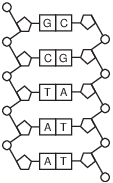Topic: Protein Synthesis Structure And Functions
Protein Synthesis Structure And Functions
Researchers use a variety of techniques to learn more about the function of a specific gene in an organism. In one type of experiment, called a loss-of-function experiment, the gene being investigated is eliminated. In a gain-of-function experiment, extra copies of the gene being investigated are inserted. The cell process most directly affected in both experiments is
(1) protein synthesis
(2) waste disposal
(3) transport of materials
(4) breakdown of nutrients
Human genetic material is represented in the diagram below.

The region labeled A is made up of a section of
(1) a protein that becomes an enzyme
(2) DNA that may direct protein synthesis
(3) a carbohydrate made from amino acids
(4) glucose that may be copied to make DNA
The diagram below represents a portion of a molecule found in cells of the human body.

Sequences represented by the letters in this molecule enable human cells to
(1) alter the method of absorption of material
(2) carry out asexual reproduction by meiosis
(3) synthesize enzymes from organic molecules
(4) modify genetic recombination during mitosis
A cell is represented in the diagram below.

The coded information that the cell uses to synthesize many different proteins is stored in structure
(1) A
(2) B
(3) C
(4) D
Changes made during the copying process are represented by * in the diagram.

The errors indicated by * could affect a cell by
(1) altering the number of chromosomes present in the cytoplasm
(2) converting the original cell into a different type of cell
(3) converting sugar molecules into molecules of protein
(4) changing the sequence of amino acids during the formation of a specific protein
Changing one base in a gene could have the most direct effect on the
(1) function of the membrane of a cell
(2) sequence of building blocks of a protein found in a cell
(3) number of mitochondria in a cell
(4) type of carbohydrates synthesized by a cell
DNA is able to control cellular activities most directly by regulating the process of
(1) meiotic division
(2) protein synthesis
(3) active transport
(4) selective breeding
The expression of a trait is directly dependent on the
(1) arrangement of amino acids in the protein synthesized
(2) shape of the subunits in the DNA molecule
(3) number of chromosomes present in the nucleus
(4) sequence of bases coded for by the ribosome
The colors and scents of plants attract helpful insects and repel insects that feed on them. The production of the proteins that provide these colors and scents is the direct result of the
(1) behavior learned from parent plants
(2) presence of specific genes
(3) the genetic makeup of the surrounding vegetation
(4) inability of plants to move as animals do
All the information necessary for growth, development, and eventual reproduction of sexually reproducing organisms is present in
(1) sperm cells, only
(2) egg cells, only
(3) zygotes
(4) either sperm cells or egg cells
Which organic compounds would be the best to analyze in order to determine if two species are closely related?
(1) fats
(2) starches
(3) sugars
(4) proteins
Which statement is an accurate description of genes?
(1) Proteins are made of genes and code for DNA.
(2) Genes are made of proteins that code for ni- trogen bases.
(3) DNA is made of carbohydrates that code for genes.
(4) Genes are made of DNA and code for pro- teins.
In 2003, as a result of the Human Genome Project, the complete sequence of all the bases in human DNA was released to the public. Although knowing the entire sequence of bases has proven valuable, scientists are currently working to map genes. Mapping genes involves determining the exact location of each gene. Since much of human DNA does not code for a protein, it is challenging to figure out which segments are actual genes. Often, scientists look at the percent composition of bases in a segment of DNA. If the segment of DNA has a large percentage of C and G bases (together over 50%), it is likely that it is a gene and codes for a protein.
Is it likely this segment of DNA codes for a protein? Circle yes or no and support your answer. [1]
Circle one: Yes or No
Allow 1 credit for circling yes and supporting the answer. Acceptable responses include, but are
• not limited to:
• — because there are high percentages of C and G bases
• — because the percent of C and G is over 50%
• — because the segment of DNA is most likely a gene
• Note: Allow credit for a response that is consistent with the student’s response to question 13.
DNA samples were taken from three different species and used to determine the amino acid sequence for a portion of a particular protein. The amino acids were then compared in order to determine which species were most closely related. Some of the information is shown on the table below.
TGA ACU
TGA ACU THR AGA UCU SER

State one specific effect on the protein produced if an mRNA code is changed from AGU to AGA. [1]
Allow 1 credit. Acceptable responses include, but are not limited to:
• — The amino acid ARG will be substituted for SER.
• — The shape of the protein might change.
• — The protein might not work.

Identify the type of building block represented by the letters A, B, and C. [1]
___________________________________________
Allow 1 credit for amino acids or peptides.
